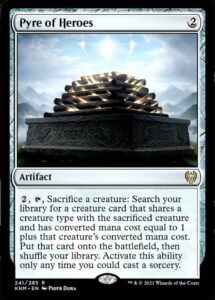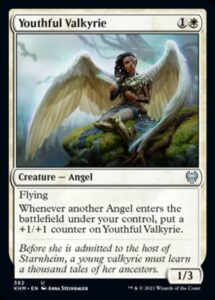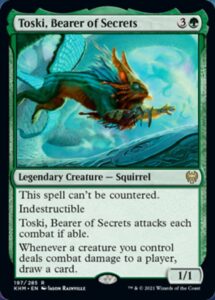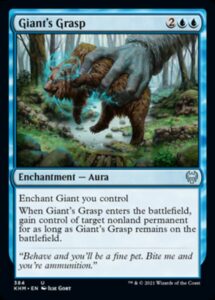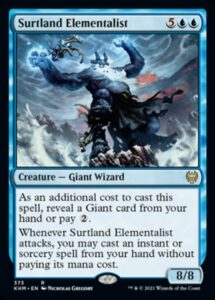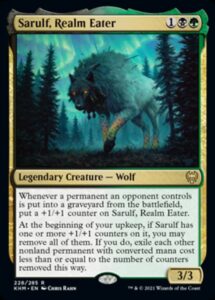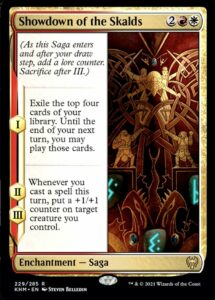With spoiler season set to begin in two days, I’m chomping at the bit to see the first set of 2021. Kaldheim is a world I’ve wanted to visit for years—heck, I built a custom set around it way back in 2012. (No, I’m not surprised that Magic didn’t include Snowfall—it has issues.) Fortunately, Wizards has released several previews already, so we’re going to peruse some of them to see what they teach us about Kaldheim in particular and design in general.
Pyre of Heroes is a clear callback to Birthing Pod, one of Magic’s coolest engines ever. We’ve seen plenty of takes on Birthing Pod, be it in early Magic with Defense of the Heart, Food Chain, and Natural Order, or newer cards like Fiend Artisan, Prime Speaker Vannifar, and Enigmatic Incarnation. It’s a popular, splashy effect that normally is only available to green mages. Pyre of Heroes takes this modular engine and shares it with all colors at a discount, but with a catch.
It’s easy to miss in eight lines of text, but Pyre of Heroes only Neoforms a creature into a creature with the same creature type. That’s a fair restriction, both to make for more interesting deckbuilding restrictions than chaining value creatures and to fit in a tribal set where Changeling creatures can fill gaps in the chain. I don’t expect Pyre of Heroes to replace Birthing Pod anytime soon with its tribal restriction and always requiring two mana, but it seems like a great tool for players to have fun building around.
While Youthful Valkyrie won’t be appearing in draft boosters, she’s the kind of card draft formats really benefit from. Tribal sets often have one or two tribes that hew on the expensive side. Treefolk and Giants in Lorwyn, Dinosaurs in Ixalan, and Angels in Avacyn Restored all struggled to fill the lower parts of their curves with in-tribe cards. Youthful Valkyrie is the rare (er, uncommon) cheap angel that angel-heavy decks need. She gives a clear explanation as for why she’s not a 3/3 (the minimum stats for most angels)—she’s not yet a full-fledged battle angel. She provides a simple quest with a strong payoff—play lots of angels and she’ll grow as big as her fellows (if not bigger).
To paraphrase Susan McKinley Ross, games benefit from having bingos players can aim for as they chase the big prize: winning. They provide direction for play and positive feedback when you satisfy their quests. Frankly, the only thing I suspect keeping Youthful Valkyrie from draft boosters is her power level—if there are enough angels and Changelings to reliably trigger her twice by turn 5, that’s probably too unbalanced without being splashy enough to bump her up to rare. This is a solid design, one I look forward to seeing more of with future tribal sets, and one I wouldn’t be surprised to see in a Masters set going forward.
MaRo finally, finally got his wish. Squirrels didn’t just get a one-off return to Standard with Helica Glider, they now has their first Standard-legal legendary squirrel with this take on Ratatoskr. And it’s pretty pushed, as befits a Squirrel God (that requires no devotion).
I appreciate how Toski, Bearer of Secrets is designed to annoy control decks but be less effective elsewhere. It circumvents most forms of interaction but is stopped cold by the mighty Squire interacting in the most common manner: blocking. Toski having to attack is a smart choice, denying it the grindy play pattern of being an overly effective blocker. I look forward to hearing stories of Toski feeding its owner too many secrets and decking them.
I love Giant’s Grasp. It tells the exact same story of Might Makes Right, but so much simpler. I love how it tells a physical story via blue mechanics normally associated with mental domination. I love how it points out that giants, while classically associated with red, are often blue and rarely recognized for it. I love that this card never existed before but feels like it could have come out twenty years ago.
Speaking of giants and being overly tricky—what’s up with Surtland Elementalist? In a cycle of relatively streamlined rares, Surtland Elementalist puts Silvergill Adept‘s cost reduction ability on the most expensive card ever. This ability makes sense on cheap cards, not your curve-topper. It tells you to delay playing a giant—a tribe that by definition is big, expensive, and has trouble curving out—all so that your most expensive card isn’t even more expensive. And then the reward for playing a giants-matter seven drop is discounting your spells, which you probably have the mana to cast anyway (except you also need to spend that mana on your expensive giant you kept in your hand).
Perhaps there’s a deck that wants to play a bunch of giants, has giants worth sangbagging, and also wants to play a bunch of expensive spells; but that seems like setting players up for failure. Surtland Elementalist feels like it has too many Spike-y knobs for what ultimately wants to be a Tammy card.
Magic’s take on Fenrir is dense with text, but it all comes together in two synergistic and relatively simple abilities. Sarulf lurks as time passes and death grows its strength. It presents you with a single choice: when to let Sarulf off its leash.
It’s really smart how Sarulf, Realm Eater only allows you to remove all of its counters, rather than letting you choose how many to take off. This reduces a series of choices (which of your own cards would you like to keep) and a repetitive play pattern (repeatedly annihiliating tokens) and condenses them into a single choice: do you blow up the world or not? Sarulf exiles cards rather than destroys them so that your choice is only whether to trigger Ragnarok, not evaluating whether Sarulf would end up bigger after using its ability. And it thematically makes sense—causing Ragnarok should yield a more permanent end.
My only complaint about Sarulf is how much text it requires to tell its story. But’s that a general Magic issue, not specific to Sarulf. Magic can’t use looser English as digital card games do, since it’s a paper game and players have to perform their cards’ actions without a computer assist. Moreover, Magic has high level tournaments, so Magic-ese is employed to eliminate ambiguity, even though it can make cards harder to parse. But this a nitpick—Sarulf, Realm Eater is an excellent fusion of flavor and function.
I love that there’s a card effectively named Battle of the Bands. Yes, it doesn’t feel like there’s much white in this card and yes, it’s a bit concerning for this to exist when Escape to the Wilds was just banned, but I cannot get over how incredible this name is. It makes me excited to see what else is coming in Kaldheim.
And, well, that’s where we’ll end for the day. In just a few short days, preview season begins in earnest. A few weeks later, we’ll be playing with new cards. And, if we’re lucky, we’ll hopefully be able to safely congregate and prerelease together before 2021 is through. Until and after then, we’ll enjoy preview season and prerelease from the comfort and safety of our homes.
And, as always, thanks for reading!
Zachary Barash is a New York City-based game designer and the commissioner of Team Draft League. He designs for Kingdom Death: Monster, has a Game Design MFA from the NYU Game Center, and does freelance game design. When the stars align, he streams Magic (but the stars align way less often than he’d like).

